News Articles

The Virginia Museum of Natural History is pleased to announce that today marks the official ...
August 31, 2020
The Virginia Museum of Natural History is pleased to announce that today marks the official beginning of Dr. Hayden Bassett's tenure as the museum's Assistant Curator of Archaeology! In this role, Dr. Bassett will foster the museum's long tradition of zooarchaeology, while shepherding the program along new avenues, such as studies of enslaved communities in Virginia. Dr. Bassett holds a Ph.D. in Anthropology from William & Mary and comes to the museum after serving as an archaeologist for the United States Department of Defense. As a DOD archaeologist, Dr. Bassett spent the past two years surveying cultural sites from around the world. Welcome aboard, Dr. Bassett! We look forward to your continued contributions to the ...
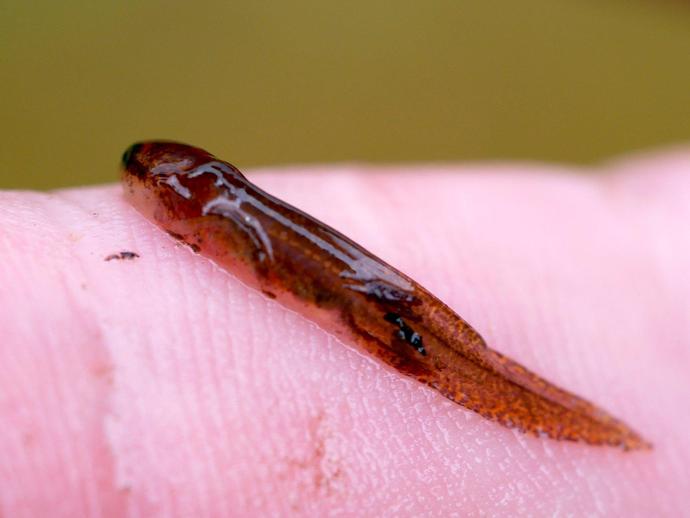
It may not look like much out of the water ...
August 31, 2020
It may not look like much out of the water, but this little fellow is most likely a larval eastern newt (Notophthalmus viridiscens). The eastern newt has quite an interesting life cycle. As larva, they have gills and don't leave the pond where they hatched. After about three months, they shed their gills, turn bright orange, and develop little red spots rimmed with black; during this juvenile stage, they are known as "red efts" and they take to land, traveling far and wide in search of a new pond. After two to three years, they will find a suitable pond, crawl into the water, and transform a third time! They turn a dull olive color with a yellow belly, grow a blade-like tail for swimming, and often spend the rest of their ...
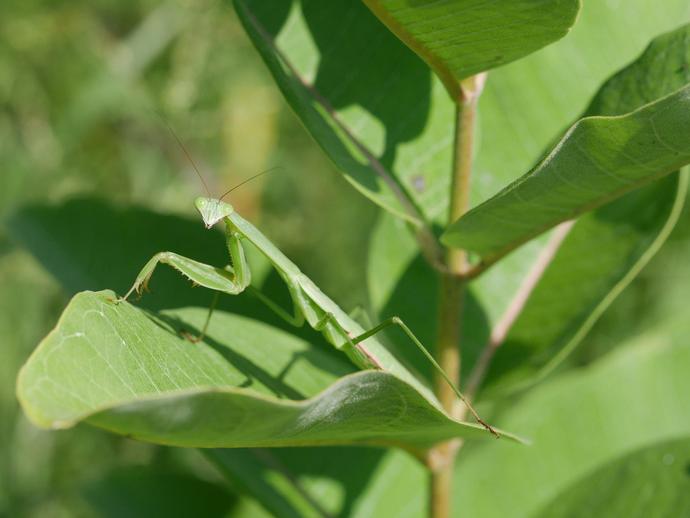
The Chinese mantis (Tenodera sinensis) is the largest mantis in North America ...
August 30, 2020
The Chinese mantis (Tenodera sinensis) is the largest mantis in North America, and they can be either brown or green in color. As the name suggests, these mantises are not native to the U.S.; their native range includes China, Japan, the Koreas, Micronesia, and Thailand. These critters were first introduced into the U.S. in the late 1800s when they were accidentally released at a plant nursery near Philadelphia. Since then, their spread has continued unabated and many nurseries still sell Chinese mantis egg cases (or "ootheca") for people to place in their gardens. While these mantises are quite skilled at eating garden pests, they're also skilled at eating pretty much anything — including our native mantis species, ...
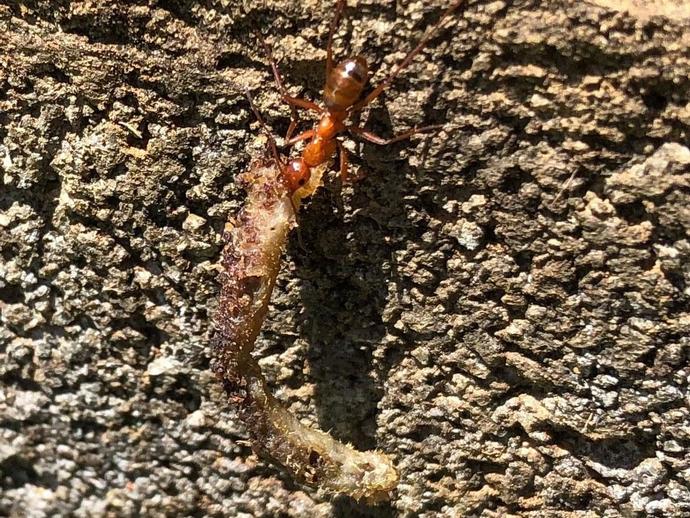
Not too long ago ...
August 29, 2020
Not too long ago, I spotted this ant from the Formica pallidefulva group carrying this dried-up piece of earthworm up a wall. It got me wondering: just how much weight can an ant carry? As it turns out, about six years ago, a group of engineers at Ohio State University came up with a wonderfully weird method of testing that exact question. They decided to determine just how much weight an ant's neck joint could withstand. The way they did this was by taking a bunch of ants, anesthetizing them, and then gluing their heads to a small centrifuge. They then spun the centrifuge at high speed until the ants' bodies ... well ... flew off. "We had to put a Plexiglass barrier around the centrifuge to protect the grad students ...
In this episode of "Museum Minute" ...
August 28, 2020
In this episode of "Museum Minute", VMNH Educator Kayla Lacy highlights a Stegosaurus cast skeleton, which can be found inside the museum's special exhibit gallery! "Museum Minute" is a video series produced by VMNH education staff that highlights specimens and displays that reside inside the museum's exhibit galleries.
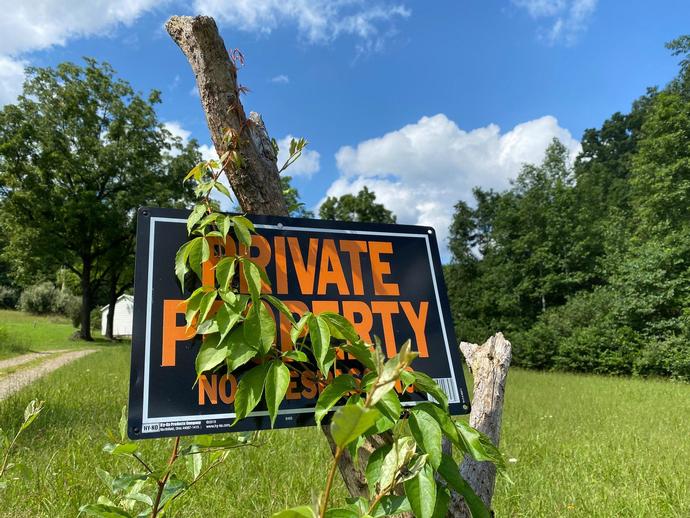
Virginia creeper is more than just my college nickname; it's also a climbing vine!
August 28, 2020
Virginia creeper is more than just my college nickname; it's also a climbing vine! Also known as five-leaved ivy and Victoria creeper, Virginia creeper (Parthenocissus quinquefolia) is a member of the grape family Vitaceae and can be found across eastern and central North America, from Canada all the way down to Guatemala! This vine is an accomplished climber and can reach heights of as much as 100 feet (and it sometimes seems like it can reach those heights in a matter of hours). It climbs its way up even smooth surfaces using small tendrils tipped with adhesive pads. Virginia creeper is often mistaken for poison ivy (Toxicodendron radicans), although it's easy to tell the difference between the two: poison ivy has ...

Len Poulin (pictured), of the VMNH Foundation, along with VMNH Board Chairman Dr
August 27, 2020
Len Poulin (pictured), of the VMNH Foundation, along with VMNH Board Chairman Dr. Tom Benzing, Waynesboro Mayor Bobby Henderson, former Waynesboro Mayor Terry Short, Waynesboro Director of Economic Development & Tourism Greg Hitchin, and Waynesboro Parks & Recreation Director Dwayne Jones, recently contributed to a video production highlighting the planned Waynesboro campus of the Virginia Museum of Natural History. The Waynesboro campus of VMNH is planned to be constructed in downtown Waynesboro and contain about 20,000 square feet of exhibits, classrooms, and visible laboratories, as well as a green roof overlooking the South River and the Blue Ridge Mountains. The Waynesboro campus will focus on the characteristics of ...
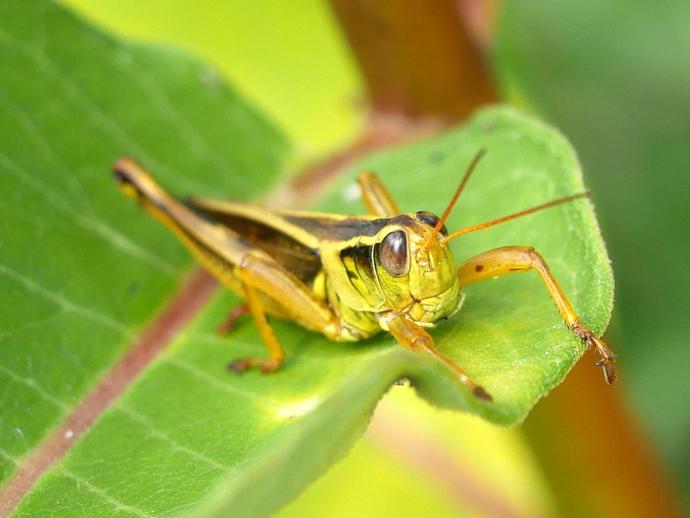
The red-legged grasshopper (Melanoplus femurrubrum) is one of our most common grasshoppers ...
August 27, 2020
The red-legged grasshopper (Melanoplus femurrubrum) is one of our most common grasshoppers, and it can be found in the U.S., Mexico, and Canada. However, depending on where you find it, it might be a different size! The farther north you go, the smaller the adult red-legged grasshoppers. This is because colder regions have shorter growing seasons, meaning that these grasshoppers need to grow up fast. The adults up north hit maturity at a smaller size so that they can more quickly reach their reproductive stage before the season ends! These grasshoppers are herbivores, and they aren't picky when it comes to the plants they'll eat. They're known as "mixed-feeding" herbivores, meaning they have to eat a variety of ...

Rick Kane ...
August 27, 2020
Rick Kane, owner and supervising broker of Westhills Realtors, recently contributed to a video production highlighting the planned Waynesboro campus of the Virginia Museum of Natural History. Rick and his wife, who is an educator, are excited for the local kids for the project! The Waynesboro campus of VMNH is planned to be constructed in downtown Waynesboro and contain about 20,000 square feet of exhibits, classrooms, and visible laboratories, as well as a green roof overlooking the South River and the Blue Ridge Mountains. The Waynesboro campus will focus on the characteristics of the Blue Ridge and Shenandoah Valley that make the region truly distinctive, such as the region's aquatic ecology, from the Big Levels ...
For our fossil enthusiast friends in and around the D
August 27, 2020
For our fossil enthusiast friends in and around the D.C. area...

VMNH Research Technician Lucy Treado and VMNH volunteer Alicia Lantz are continuing to process ...
August 26, 2020
VMNH Research Technician Lucy Treado and VMNH volunteer Alicia Lantz are continuing to process artifacts from the Claremont Manor archaeological site, which is located along the James River in Surry County, Virginia. Recently, they discovered a fragmented green glass seal among the artifacts. Alicia and Lucy gently pressed the seal into warm clay to create an impression that would minimize background noise and highlight the letters. They were able to identify the maker by scouring the web for similar design patterns. Bottled water has been a popular choice of beverage dating back to the mid 16th century, when Europe began selling natural mineral waters. (An interesting history of bottled water can be found at www. ...
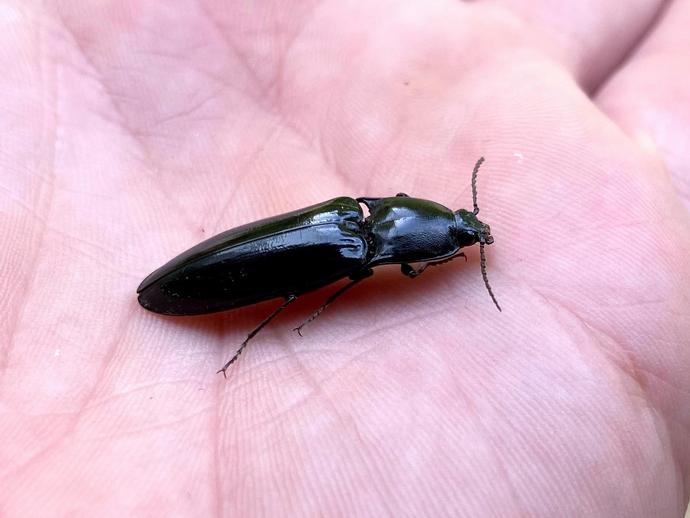
This is Melanactes piceus, a click beetle that looks like it just left a shoeshine stand!
August 26, 2020
This is Melanactes piceus, a click beetle that looks like it just left a shoeshine stand! Click beetles belong to the family Elateridae, which contains more than 900 species just in North America and more than 9,300 species worldwide! This is a larger click beetle, as most species are fairly small and are usually a drab brown or black color. A few species of click beetles are large and colorful, and some are even bioluminescent! The most impressive click beetle you're likely to find in southwest Virginia is Alaus oculatus, commonly called the eastern eyed click beetle. These are large gray beetles with white speckles and two large black eyespots on their pronotum (the plate that covers the thorax or middle section of some ...

HEY HOMESCHOOL FAMILIES!
August 25, 2020
HEY HOMESCHOOL FAMILIES! The Virginia Museum of Natural History is excited to announce that our Homeschool Science and Engineering Academy is going virtual this school year! Virtual classes start in September for ages 6 and older! Be sure to visit www.vmnh.net/homeschool-education to learn how to register today!
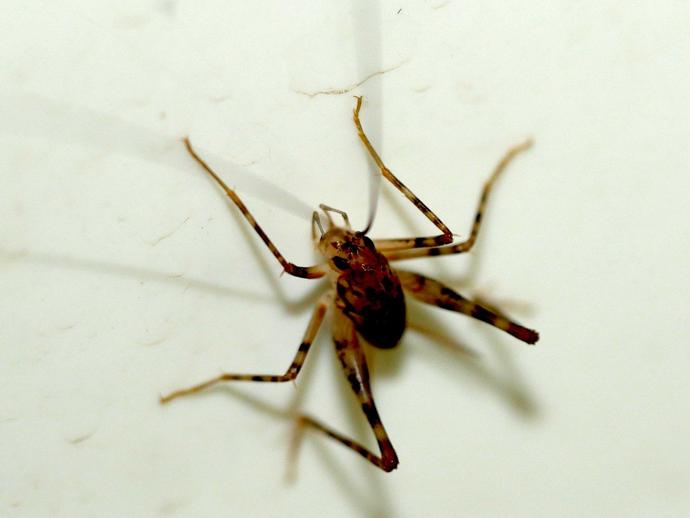
When it comes to unloved insects ...
August 25, 2020
When it comes to unloved insects, camel crickets probably rank somewhere between cockroaches and brown marmorated stink bugs. With their long limbs, twitching antennae, and tendency to erratically jump all over the place, it's not hard to see why people don't like these guys in their homes. Camel crickets belong to the cave cricket family Rhaphidophoridae, and this particular camel cricket is from the genus Ceuthophilus. They get their common name from their humped back; they definitely don't share any of the camel's other defining features, as these critters require damp, cool environments to survive. Before humans came along, these crickets would have been found in caves or underneath rotting logs and wet leaves. ...
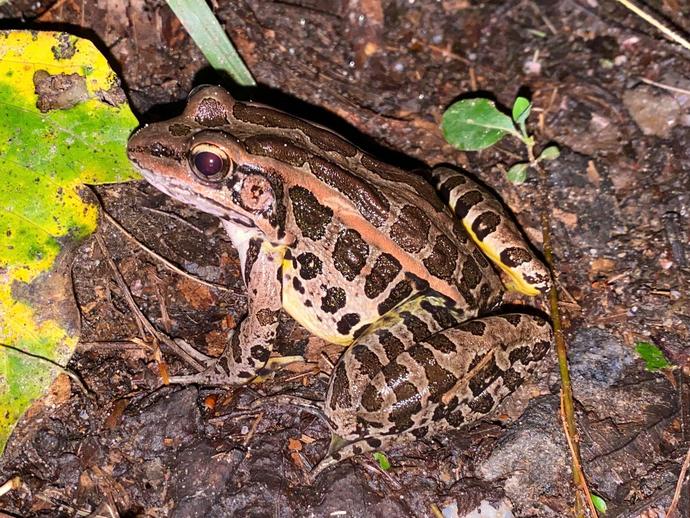
I was heading up my driveway Friday night when this fellow decided it was crucially important to ...
August 24, 2020
I was heading up my driveway Friday night when this fellow decided it was crucially important to hop in front of my car. Fortunately, I hit the brakes in time and was able to snap a photo of one of Virginia's coolest frogs: the pickerel frog (Lithobates palustris). What makes the pickerel frog truly unique is its defense mechanism: this is the only poisonous frog native to the United States! When pickerel frogs feel threatened, they emit skin secretions that are toxic to most predators (although bullfrogs and a handful of species of snakes can still eat them). While the poisonous secretions aren't fatal to humans, they can cause irritation if they get into your eyes or mucous membranes. So if you see a pickerel frog, no ...
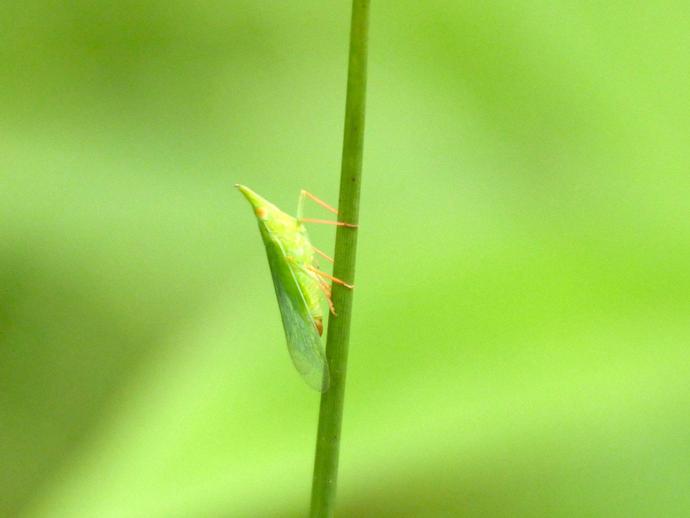
This unusual-looking little critter is Rhyncomitra microrhina ...
August 23, 2020
This unusual-looking little critter is Rhyncomitra microrhina, which is a planthopper in the family Dictyopharidae. There are more than 12,500 different described species of plant hoppers worldwide, and their common name comes from two traits: their striking resemblance to plant structures and their tendency to make short hops to get around. However, they often just walk around slowly so they don't draw attention from predators. One of the main reasons I wanted to share this insect is because when I first saw it, I had no idea what it was. I thought it might be a planthopper of some kind, but I wasn't entirely sure and I had to consult several websites and ask VMNH Associate Curator of Invertebrate Zoology Dr. Kal Ivanov ...
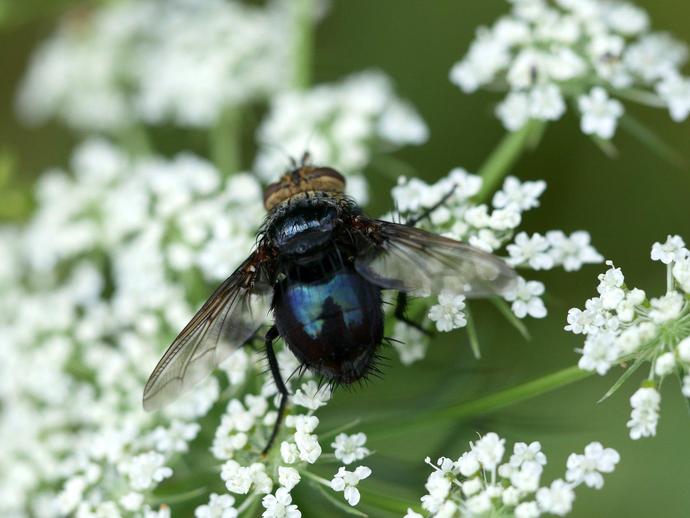
When we think of flies, we usually think of them as being drawn to garbage and other gross stuff
August 22, 2020
When we think of flies, we usually think of them as being drawn to garbage and other gross stuff. However, there is an enormous amount of variety among flies, and they have evolved all kinds of unique ways to survive and reproduce. This particular fly belongs to the genus Archytas, named after the classical Greek philosopher and mathematician of the same name. Flies within this genus belong to the tribe Tachinini, which falls within the Tachinidae family of flies. There are more than 1,300 species within this family just in North America, and more than 8,200 known species worldwide! Tachinid flies don't lay their eggs in garbage or dead critters like house flies do. Instead, they lay their eggs on other insects. In most ...
In this episode of "Museum Minute" ...
August 21, 2020
In this episode of "Museum Minute", VMNH Educator Terri Robertson highlights the museum's Platecarpus cast skeleton, which can be found suspended from the ceiling of the Harvest Foundation Hall of Ancient Life! "Museum Minute" is a video series produced by VMNH education staff that highlights specimens and displays that reside inside the museum's exhibit galleries!
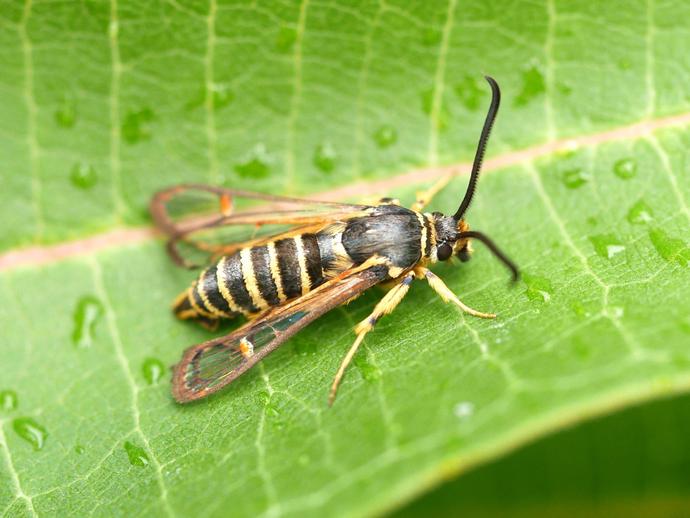
"Ah," you are perhaps thinking to yourself, "it appears we're looking at another wasp today
August 21, 2020
"Ah," you are perhaps thinking to yourself, "it appears we're looking at another wasp today. I was hoping for something more exciting to close out my week." Well buckle your seat belt, my friend, because this is a MOTH! Meet Pennisetia marginata, also known as the raspberry crown borer or blackberry clearwing borer. These moths belong to the family Sesiidae, the clearwing moth family. Clearwing moths are a prime example of what's known as "Batesian mimicry," which is when a harmless species evolves to imitate the warning signs of a harmful species! By resembling a wasp, this moth has the benefit of being avoided by many predators without having to bother with developing defenses. Many of the moths in the family Sesiidae ...
In this episode of "Tales of Ancient Life", Assistant Curator of Paleontology Dr
August 20, 2020
In this episode of "Tales of Ancient Life", Assistant Curator of Paleontology Dr. Adam Pritchard highlights the extraordinary past diversity of the members of the crocodile family by highlighting the strangest of all crocodylomorphs (at least, in Dr. Pritchard's opinion), Simosuchus!
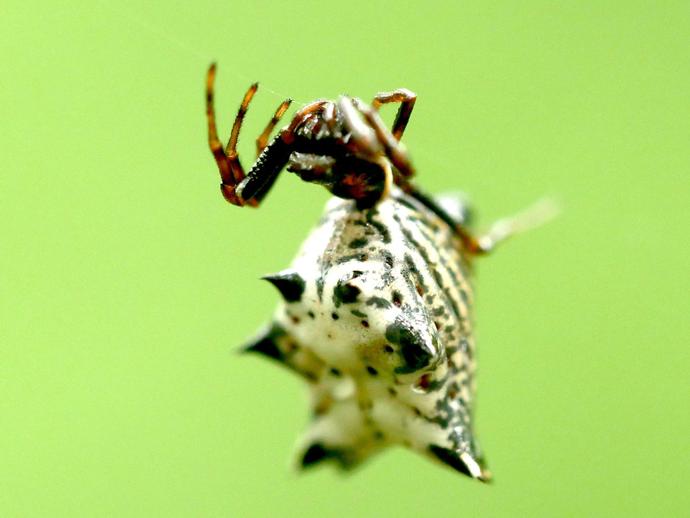
Behold the spined micrathena (Micrathena gracilis) ...
August 20, 2020
Behold the spined micrathena (Micrathena gracilis), a spider that looks like it's perpetually dressed up to go see Iron Maiden! The spined micrathena belongs to the orb weaver family Araneidae, which are the spiders that build the iconic wheel-shaped webs (the web didn't show up in this picture; don't worry, the spider isn't actually hovering in mid-air). This spined micrathena is a female. The males are much smaller and lack all but one or two of the characteristic spines on the abdomen. The females, while larger, are still pretty tiny; they top out at around 8-10 mm in length. Despite their intimidating appearance, they're harmless to humans. These spiders are most commonly encountered near the end of summer and ...
Today's Ask an Expert is a twofer: Eli asks where fossils come from ...
August 19, 2020
Today's Ask an Expert is a twofer: Eli asks where fossils come from, while Niall asks what killed the dinosaurs. Fortunately, VMNH Assistant Curator of Paleontology Dr. Adam Pritchard has the answers! If you'd like to submit a question to Ask an Expert, just record a short video of your question and send it to us through Facebook Messenger! Note: We may not be able to answer every question, but we'll get to as many as we can!
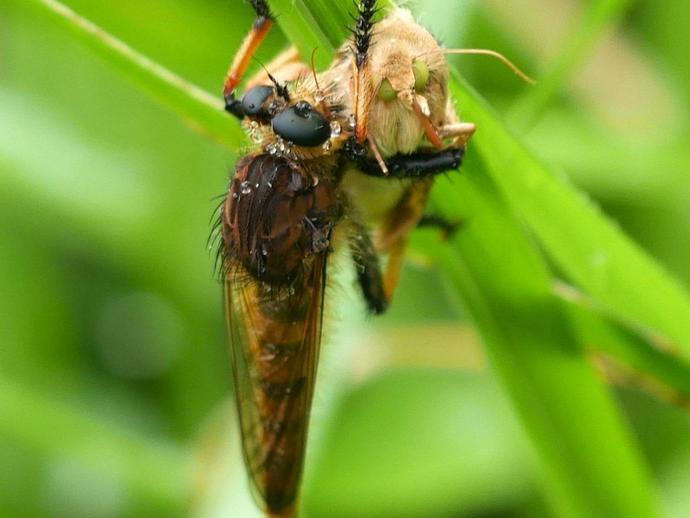
Promachus rufipes ...
August 19, 2020
Promachus rufipes, also known as the red-footed cannibalfly or bee panther, is one fierce little predator. If you don't believe me, just ask the unfortunate moth that this one captured! The red-footed cannibalfly belongs to the family Asilidae, members of which are commonly called "robber flies." Robber flies are voracious ambush predators; during the warmest hours of the day, they take a strategic position in an open sunny area where they watch and wait. Once they see an enticing-looking insect fly by, they take off and catch it in mid-air! Once they've caught something, they use their short, powerful proboscis to inject it with neurotoxic enzymes that paralyze the prey and digest its insides, which they then suck up ...

Within the past year ...
August 18, 2020
Within the past year, the museum has lost two tremendous friends and supporters in William Bruce Wingo and Cindy Eanes Gray. While the impact of their losses will be felt for many years to come, the museum wants to ensure that their memories continue to be celebrated! In honor of Bruce's memory, the museum has recently announced that the Thomas Jefferson Award formerly known as the "The Thomas Jefferson Award for Conservation", is now the "W. Bruce Wingo Award for Outstanding Contributions to Conservation". We look forward to celebrating Bruce's long and impactful support of the museum at the next Thomas Jefferson Awards Ceremony, which, due to the current health situation, will be held at a yet to be determined date in ...
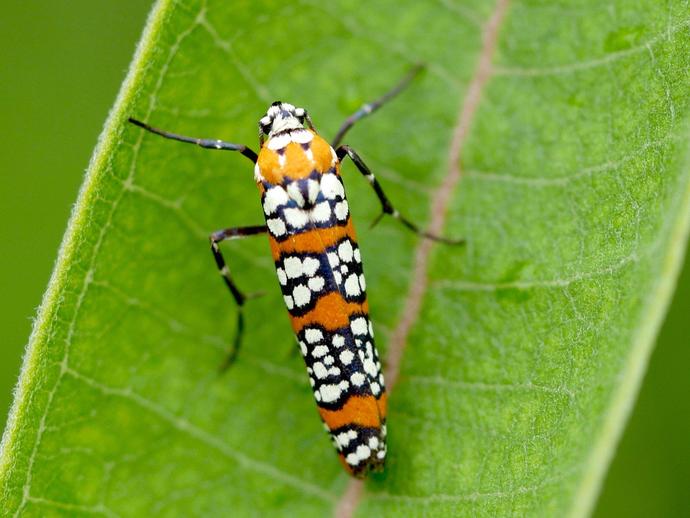
If you've ever wanted to see a moth that looks like it borrowed a pattern from the couch your ...
August 18, 2020
If you've ever wanted to see a moth that looks like it borrowed a pattern from the couch your great-aunt bought in 1977, then look no further than the ailanthus webworm moth (Atteva aurea)! These small moths are pretty common in southwest Virginia, although that wasn't always the case! It's believed that they are originally native to south Florida and Central America, which is the home of their original larval host plant: Simarouba glauca, the paradise tree. However, around the middle of the 19th century, they began gradually spreading north. Why did that happen? Well, in the mid-18th century, another subject of a recent nature post was brought to America: Ailanthus altissima, the "tree of Heaven." These invasive trees ...
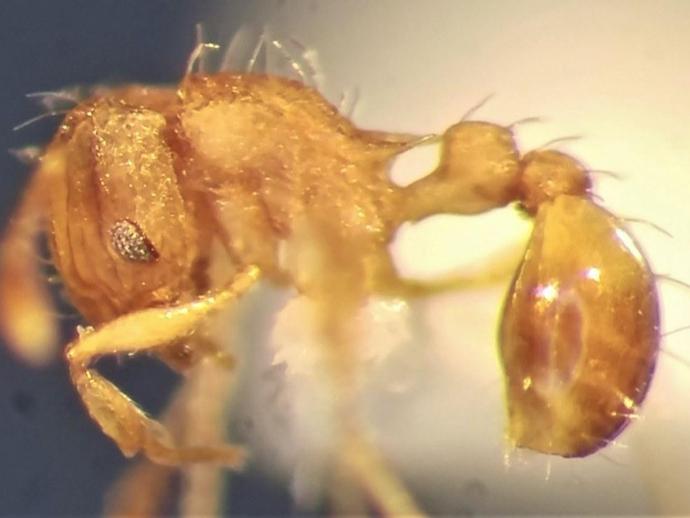
Virginia's first specimen of the invasive Little Fire Ant ...
August 17, 2020
Virginia's first specimen of the invasive Little Fire Ant, Wasmannia auropunctata, discovered in Lee County, Virginia! Virginia's first, and to date only, specimen of the infamous Little Fire Ant was recently discovered by VMNH Biology Technician Liberty Hightower and Associate Curator of Recent Invertebrates Dr. Kal Ivanov in a backlogged leaf-litter sample collected by beetle expert Dr. Bob Anderson (Canadian Museum of Nature) in Lee County back in 2016. Named for its painful sting, the Little Fire Ant, a.k.a. the Electric Ant, is one of Virginia's smallest ants. Measuring only 1.5 mm (~ 0.06 inches) in size, it is barely visible to the naked eye, but packs a powerful sting that is out of proportion to the ant's ...
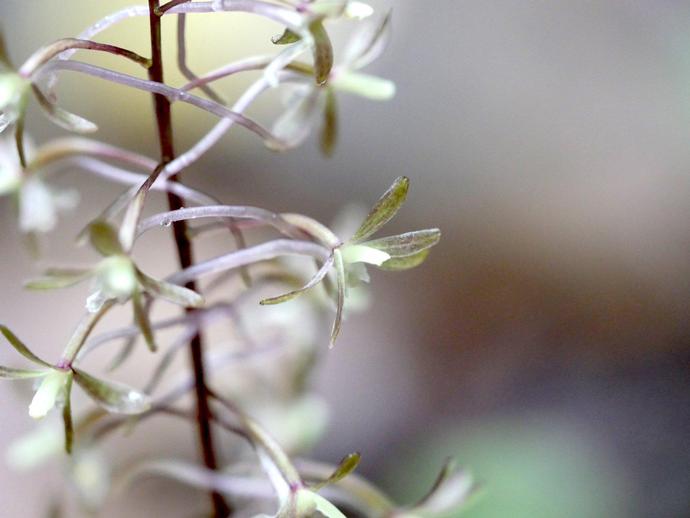
While it may not be quite as striking as the pink lady's slipper orchid (Cypripedium acaule) ...
August 17, 2020
While it may not be quite as striking as the pink lady's slipper orchid (Cypripedium acaule), the cranefly orchid (Tipularia discolor) is still a beautiful plant! This is the only orchid within the genus Tipularia that can be found in North America and it is mainly found in the southeast, although its range extends up into the Catskills. There are also a few isolated populations in the Great Lakes area. Like many orchids, this one has an interesting method of pollination. The flowers are mainly pollinated by owlet moths, which visit the flowers at night to feed on the nectar. As you can see in the photos, the flowers grow slightly off-center, tilting in one direction or the other. As the moth pushes its proboscis deeper ...
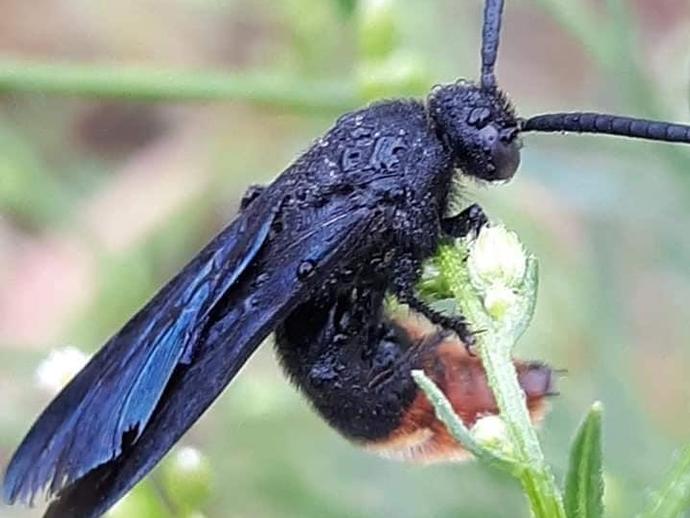
Mr
August 16, 2020
Mr. Edward Gravely of Martinsville sent us a picture of a blue-winged wasp (Scolia dubia) recently. These wasps can often be found collecting nectar from flowers in late summer. The females burrow into the earth in search of beetle grubs, particularly those of the June beetle (Cotinis nitida). The wasps sting the grubs to paralyze them and then lay a single egg on the grub, which provides food for the wasp larva. Thanks for the pic, Mr. Gravely!
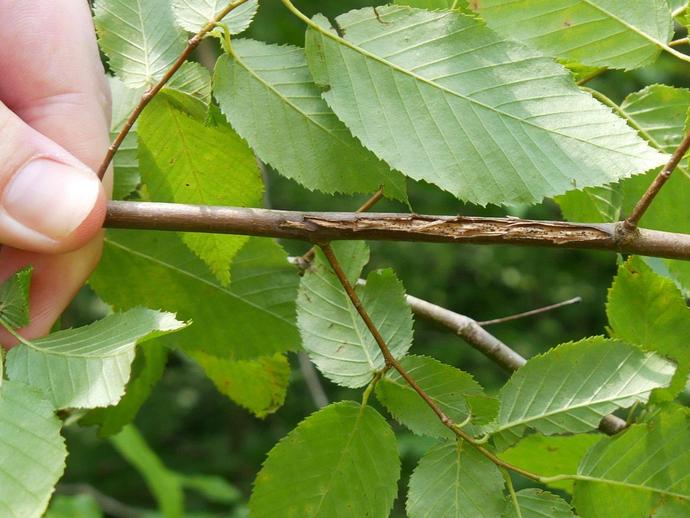
Here's something neat that I spotted a little after the periodical cicada emergence ...
August 16, 2020
Here's something neat that I spotted a little after the periodical cicada emergence, but I forgot to post the picture until I stumbled across it today. Have you ever noticed a little stripped area on a small twig like the one seen here? You've just found some cicada eggs! Or at least a spot where some cicada eggs used to be! After mating, female cicadas land on small twigs and use their ovipositors (a tubular egg-laying organ) to cut small slits in the twig's surface and lay an egg in each slit. After the eggs hatch, the tiny cicada nymphs emerge from the slits and drop to the ground. Fortunately, they're so tiny that the fall doesn't hurt them. Once they reach the ground, they dig into the earth and begin feeding on ...
Did you feel the earthquake last Saturday? In this video, VMNH Curator Emeritus of Geology Dr
August 15, 2020
Did you feel the earthquake last Saturday? In this video, VMNH Curator Emeritus of Geology Dr. James Beard explains why earthquakes travel farther on the east coast than on the west coast.
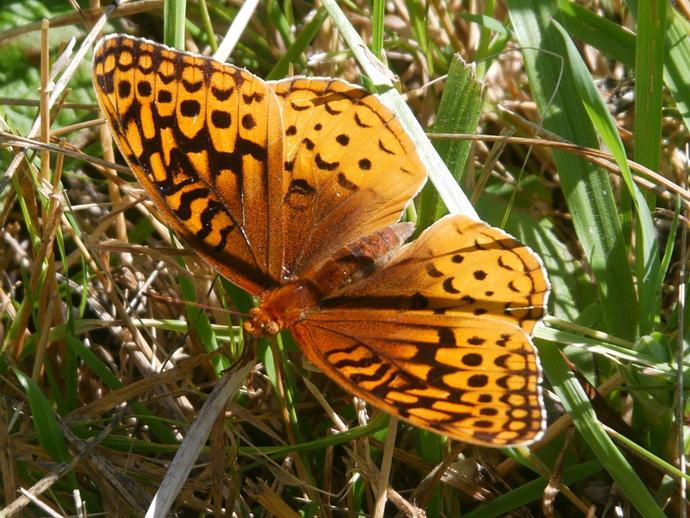
Speyeria cybele ...
August 15, 2020
Speyeria cybele, commonly known as the great spangled fritillary, is a fairly common North American butterfly that can be found just about everywhere in the contiguous U.S. except for the southwest. They can be found in fields, valleys, pastures, and open woodland, but they're most common in habitats with plenty of moisture. The adults feed on the nectar from a variety of flowers, including milkweeds, thistles, mountain laurel, and others. Interestingly, their life cycle is quite similar to the related and much rarer Diana fritillary (Speyeria diana) that I posted a few weeks back. Both species live in similar habitats and the caterpillars of both species feed on native violet plants, yet one is found throughout much of ...
In this episode of "Museum Minute" ...
August 14, 2020
In this episode of "Museum Minute", VMNH Educator Kayla Lacy provides highlights several interesting tidbits about the museum's Acrocanthosaurus, which can be found inside the Harvest Foundation Hall of Ancient Life! "Museum Minute" is a video series produced by VMNH education staff that highlights specimens and displays that reside inside the museum's exhibit galleries.
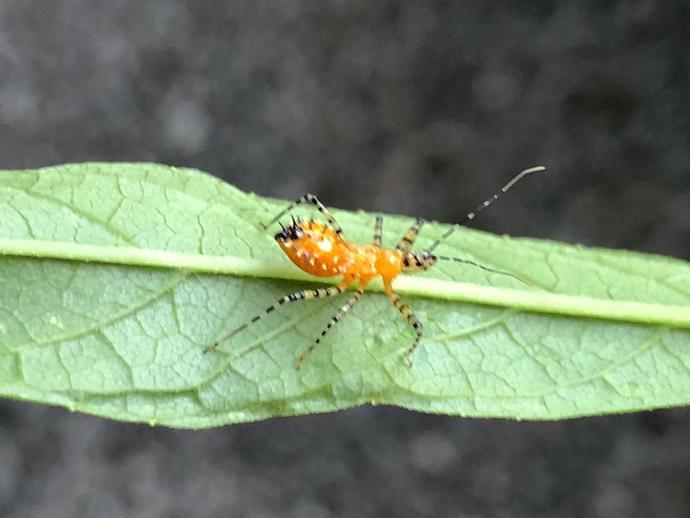
Over the last few months ...
August 14, 2020
Over the last few months, I've helped to identify a whole lot of cool insects sent in by some of the wonderful folks who follow our VMNH Facebook page. During that time, many folks have sent in pictures of assassin bug nymphs, and I can certainly see why; they're unusual-looking little critters! Assassin bugs belong to the family Reduviidae, a large family of true bugs that can be found throughout the world. Almost all assassin bugs are ambush predators, and they attack their prey by stabbing it with their sharp proboscis and injecting it with venom and/or digestive enzymes, depending on the species. Some species also have little hairs or spines on their legs to help them hold their prey while they suck up the delicious ...
How much gold is in the Earth? That's Ada's question for today's Ask an Expert video, featuring Dr
August 14, 2020
How much gold is in the Earth? That's Ada's question for today's Ask an Expert video, featuring Dr. James Beard, VMNH Curator Emeritus of Geology! If you'd like to submit a question to Ask an Expert, just record a short video of your question and send it to us through Facebook Messenger! Note: We may not be able to answer every question, but we'll get to as many as we can!
One of Virginia's most common mammals? Check
August 13, 2020
One of Virginia's most common mammals? Check. Fierce predator? Yep. A venom about as potent as a rattlesnake's? Uh-huh. And you've probably never seen one before.
In this episode of "Tales of Ancient Life", Assistant Curator of Paleontology Dr
August 13, 2020
In this episode of "Tales of Ancient Life", Assistant Curator of Paleontology Dr. Adam Pritchard highlights a giant, dome-shaped, rock structure built by millions upon millions of tiny microbes over 500 million years ago!
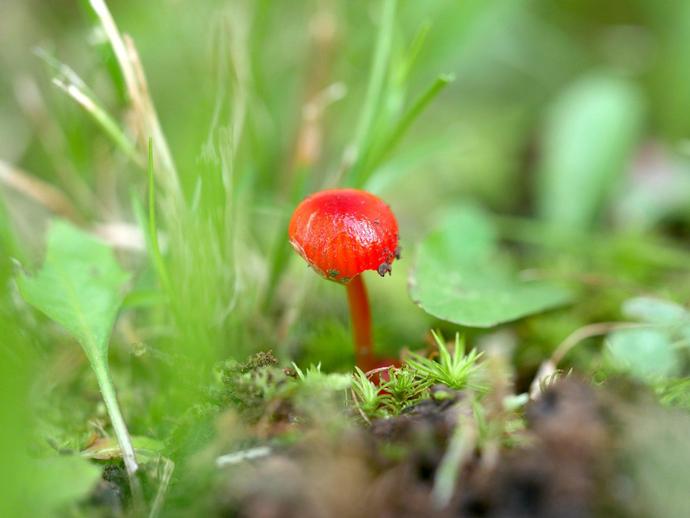
I haven't posted too many mushrooms for the same reason I don't eat wild mushrooms: I'm not very ...
August 13, 2020
I haven't posted too many mushrooms for the same reason I don't eat wild mushrooms: I'm not very good at identifying them. However, I'm reasonably certain that this little guy is Hygrocybe miniata, also known as the vermilion waxcap. These little mushrooms can be found worldwide, from the fields and heaths of Europe all the way to the rainforests. The emphasis is definitely on the word "little." The caps of these mushrooms rarely grow larger than a couple centimeters in diameter. This particular mushroom was so small that I thought it was a holly berry when I first saw it, and I ended up having to bust out my macro lens. These mushrooms are apparently edible, but they're so small that no one really bothers. In any case, ...
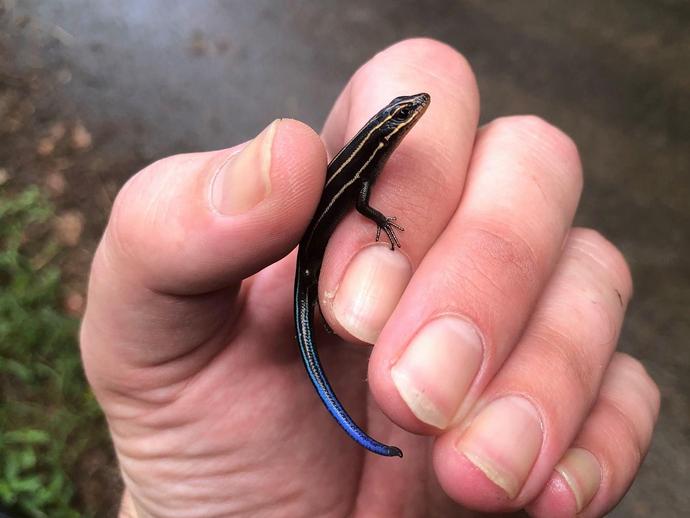
Although I did a nature update about five-lined skinks (Plestiodon fasciatus) back in June ...
August 12, 2020
Although I did a nature update about five-lined skinks (Plestiodon fasciatus) back in June, I thought today would be a good day to highlight the juveniles of the species. I hauled off some trash yesterday morning and when I opened the lid of my garbage can, I found this little guy hanging out on the rim. It immediately lost its footing and fell inside the can. Naturally, I tipped the can over and rooted through trash until I could scoop the little idiot out. It rewarded my kindness by biting my thumb several times. Five-lined skinks are very common in southside Virginia and you've probably seen several of them this spring and summer. Now is a good time to keep an eye peeled for juveniles like this one. These skinks begin ...

American pokeweed (Phytolacca americana) is native to the eastern U
August 11, 2020
American pokeweed (Phytolacca americana) is native to the eastern U.S., the Gulf Coast, and the Midwest, but it's probably most iconic in southern Appalachia. Back in the old days, people used to harvest the leaves and stems of young pokeweed plants to make "poke salad" or "poke sallet." Now I'm going to tell you why you should never do that! While it is possible to (more or less) safely prepare pokeweed in the traditional Appalachian way, the risk ain't exactly worth the reward. All parts of the plant are toxic and become increasingly toxic as the plant matures. The roots and berries are particularly dangerous. You should be very careful if you have young children and pokeweed on your property; little kids often try to ...
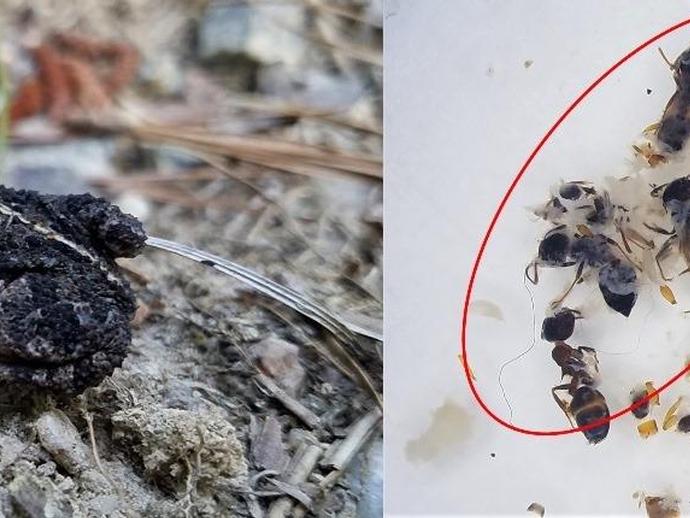
Even dead toads can tell a story! VMNH Associate Curator of Recent Invertebrates Dr
August 11, 2020
Even dead toads can tell a story! VMNH Associate Curator of Recent Invertebrates Dr. Kal Ivanov and VMNH Research Associate Jason Gibson recently initiated a long-term study on the diet of Virginia's herpetofauna (reptiles and amphibians of a particular region). Recent work included examination of the stomach contents of two unusual toad species: the Oak Toad, Anaxyrus quercicus, and the Eastern Narrow-mouthed Toad, Gastrophryne carolinensis. Similar to other toad species, these toads are known to consume a variety of small invertebrates. However, their favorite food appears to be ants. Working through the stomach contents is sort of like putting together a (gross) jigsaw puzzle; many prey items are highly fragmented and ...
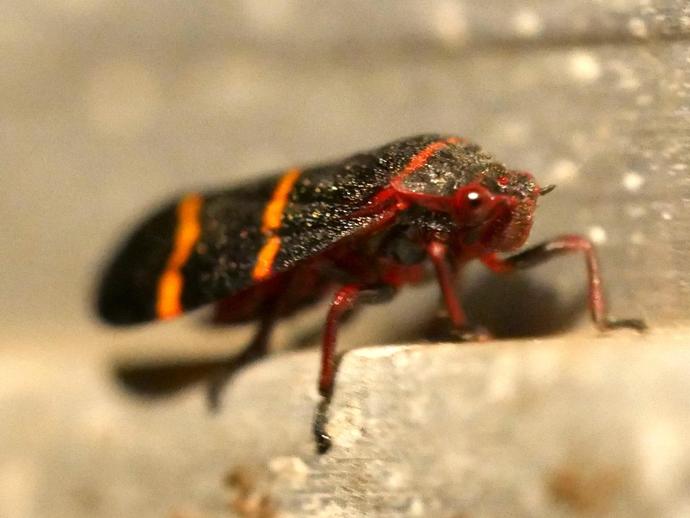
Back in May ...
August 10, 2020
Back in May, we looked at spittlebugs, which are the tiny little insect nymphs that hide inside a protective barrier of foam on the stems of plants (you can see an example of a spittlebug in the second picture). If you were left wondering what the adults look like, then today is your lucky day! This is Prosapia bicincta, also known as the two-lined spittlebug. Adult spittlebugs are also known as "froghoppers" because of their incredible jumping skills. Froghoppers jump from one plant to another, and some species can jump more than two vertical feet! While fleas get all the credit for their jumping abilities, relative to their body weight, the froghopper is actually the more impressive jumper! Looking at this froghopper ...
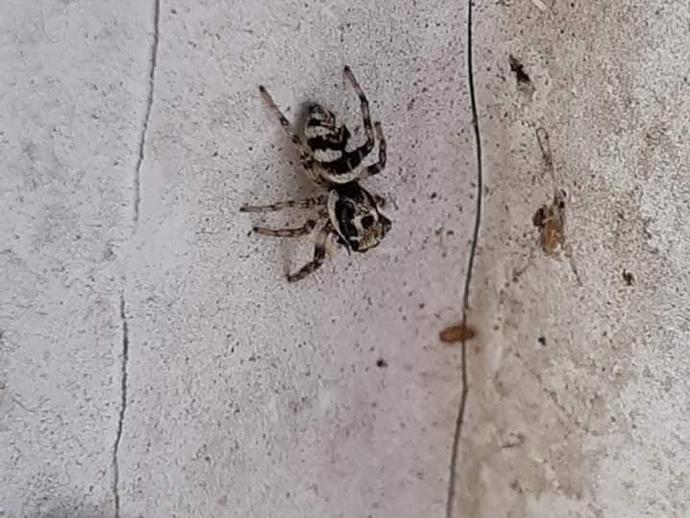
Mr
August 9, 2020
Mr. Edward Gravely of Martinsville sent us a picture of a zebra jumping spider (Salticus scenicus) recently. It's probably pretty obvious how it gets its common name! These small jumping spiders can be found throughout North America and Europe, and they commonly take on prey items up to three times their size! Thanks for the pic, Mr. Gravely!
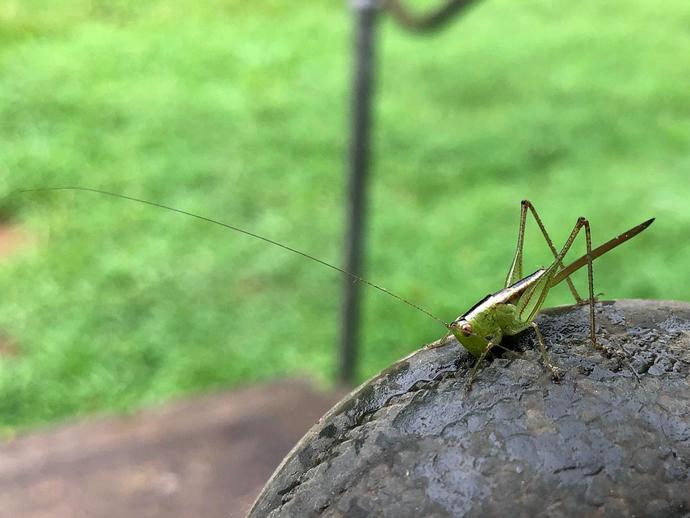
This little lady that I found hanging out on the toe of my boot is Conocephalus strictus ...
August 9, 2020
This little lady that I found hanging out on the toe of my boot is Conocephalus strictus, also known as the straight-lanced meadow katydid. When we think of katydids, we usually think of the larger species that tend to show up to porch lights at night. However, katydids come in a variety of sizes. This particular species is identifiable by the length of the ovipositor, which is the tube-like organ that some insect species use to lay their eggs. The females of Conocephalus strictus have an ovipositor longer than their body, which is where their common name (straight-lanced) comes from! Katydids are responsible for a lot of the insect noises that we hear on summer evenings. This species produces a faint purring noise with ...
In this episode of "Tales of Ancient Life", Assistant Curator of Paleontology Dr
August 8, 2020
In this episode of "Tales of Ancient Life", Assistant Curator of Paleontology Dr. Adam Pritchard highlights a recent field trip he and several colleagues took to Ashland, Virginia, where they discovered multiple small reptile fossils from the Triassic Period!
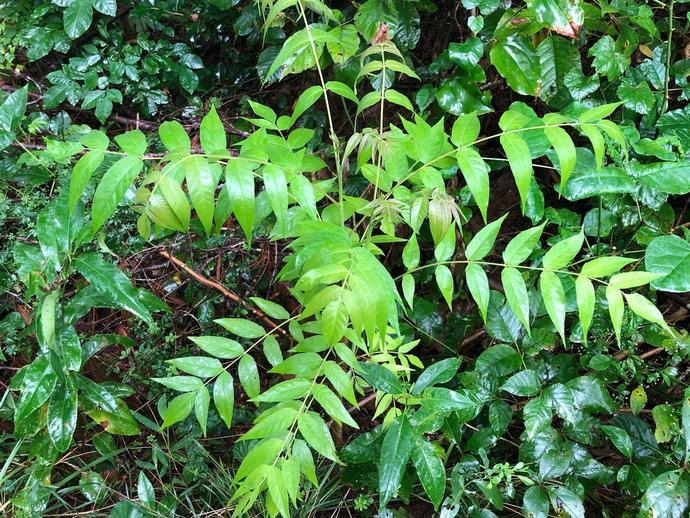
Ailanthus altissima is commonly known as the "tree of Heaven ...
August 8, 2020
Ailanthus altissima is commonly known as the "tree of Heaven," and frankly, Heaven should consider suing it for defamation of character. In its native China, this plant has a much more accurate name: 臭椿, which means "foul smelling tree." Ailanthus altissima is native to northeast and central China, but it was brought to Europe in the 1740s and the U.S. in 1784. It was initially considered a beautiful tree to plant in the garden, but gardeners soon discovered two unfortunate facts about the tree: one, it has a foul smell, especially while flowering, and two, it's nearly impossible to kill. Today, it is internationally recognized as an invasive species. There are a number of qualities that make tree of Heaven ...
In this episode of "Museum Minute" ...
August 7, 2020
In this episode of "Museum Minute", VMNH Educator Terri Robertson is inside the museum's "Uncovering Virginia" exhibit to highlight a recreation of an archaeological trash pit from hundreds of years ago! Trash pits may not sound like much, but they can provide archaeologists with many important insights into the lives of people and societies living many years before us! "Museum Minute" is a video series produced by VMNH education staff that highlights specimens and displays that reside inside the museum's exhibit galleries!
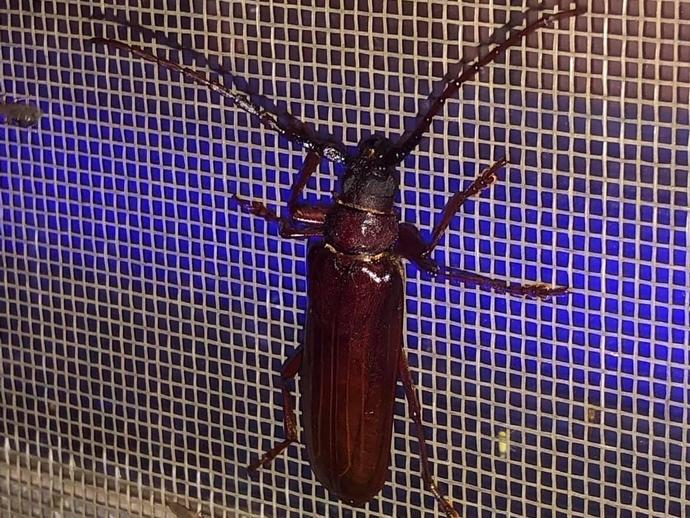
Several years ago ...
August 7, 2020
Several years ago, I was hanging out in my friend Bradley's basement when I felt a tickle on my leg. I reached down to scratch my leg and felt a distressingly large lump on my calf ... and then the lump made a squeaking noise. I learned two things that night: that the brown prionid beetle is capable of squeaking, and that when properly motivated, I can shed my pants in less than half a second. The brown prionid beetle (Orthosoma brunneum) is a fairly common large beetle, and it's the only species within its genus! Like many longhorn beetles, these beetles lay their eggs in rotting wood. The larvae feed on the dead wood while the adults feed on tree leaves. Of course, one of the most unique features of the brown prionid ...
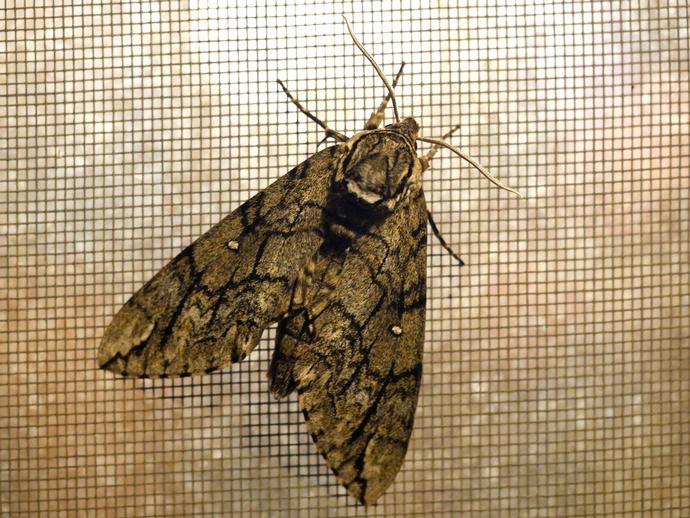
If you've been following these nature posts ...
August 6, 2020
If you've been following these nature posts, you've probably noticed that I like to post cool moths. There are two in particular I'm still hoping to spot: the Luna moth (Actias luna), which seems to be everyone's favorite, and the cecropia moth (Hyalophora cecropia), which is the largest moth native to North America. While I haven't spotted those two yet, it seems like just about every other large moth in Virginia has paid a visit to my back porch, including today's critter: Ceratomia undulosa, the waved sphinx. While this may not be the most striking moth around, it is pretty big, as you can see in the comparison photo with my orangutan-esque hand. Caterpillars of the waved sphinx primarily feed on the leaves of ash ...
How many sharks are in the world's oceans?
August 5, 2020
How many sharks are in the world's oceans? That's Sophie's question for today's Ask an Expert video! If you'd like to submit a question to Ask an Expert, just record a short video of your question and send it to us through Facebook Messenger! Note: We may not be able to answer every question, but we'll get to as many as we can!

Virtual programming is coming soon for all ages!
August 5, 2020
Virtual programming is coming soon for all ages! Homeschool Science & Engineering Academy, Doodle Bugs, Science Talks, K-12 programming, and more! Stay tuned for details!
Archives
2026
2025
2024
2023
2022
2021
2020
2019
2018
2017
2016
2015
2014
2013
2012
2011
2010
2009
2008

Please Visit Us Soon
Hours:
Tuesday - Saturday: 10am - 4pm
Sunday: Noon to 4pm (Memorial Day Weekend through Labor Day Weekend only)
Monday: Closed
Admission:
$12 for ages 18-59
$6 for ages 3-17, seniors 60+, and college students
FREE for children under 3, museum members, members of ASTC Passport participating institutions, and EBT cardholders
My 4 year old son loves going to the museum. The exhibits are educational, interactive and kid-friendly.
”

 Hours & Admissions
Hours & Admissions Directions
Directions